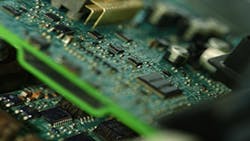A Call for Collaborative Development of Digital Power Solutions
Digital power technology has the potential to address the power and thermal challenges facing the computing industry. For that to happen, the power electronics industry must work together with OEMs in computing to create suitable products. That message was conveyed by Dr. Scott D. Strand of IBM yesterday in his keynote talk at the Power Electronics Technology Conference in Baltimore. Strand, who is IBM’s program director of Power/Cooling Procument Engineering, explained that for OEMs such as IBM to implement digital power solutions they “need standardization without sacrificing function and capability.”
To achieve that goal, Strand called on members of the power electronics community to work together to “achieve cooperation among component suppliers, power supply suppliers and end users. And I believe this can be done without sacrificing profit margin, without sacrificing intellectual property and without sacrificing competitiveness.”
In his talk, “Future Power Technology in the Global Marketplace—A Customer Perspective,” Strand noted that his company sees a number of benefits that could be gleaned from using digital power management. “The key one is a reduction in development, qualification and manufacturing costs…We can have one common set of hardware that just gets programmed at the system level. That’s perfect.”
Strand also cited flexibility as a major benefit since power supply problems encountered during manufacturing or in the field can be addressed via a programming change rather than by redesigning the pc board. He also noted that digital power management allows for “unlimited parameter monitoring” and “continual quality improvement.”
“We can do data mining on information that comes back from that [parameter monitoring]," said Strand, “and potentially predict when failures would occur and preemptively exchange power supplies…We could monitor power usage in a system and the system itself could move workload back and forth to different parts of the data center.”
However, given the current technology, there are barriers to implementing digital power management. These barriers include legacy systems because digital power solutions do not represent a “drop-in replacement.” There also is the perception that digital power management will cost more. Strand described this latter issue as the key barrier and commented that if nothing is done in the industry (i.e., to create standard digital power solutions), digital power will cost more than existing analog solutions.
Another problem is the scarcity of digital power experts in the industry. “You can hire a bunch of software folks or digital designers, but if they don’t have the understanding in the history of analog power trains…it’s not going to do any good.”
Returning to the theme of standardization, Strand explained how the lack of it at the component level hinders deployment of digital power solutions by users. “The way things are going today…each of the semiconductor manufacturers that’s working on digital power has their own proprietary system, their own proprietary tools, and if there isn’t some coordination among end users to try and deliver the standardized solution, no one will get what they need out of [digital power].”
